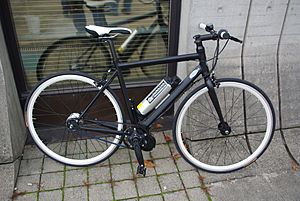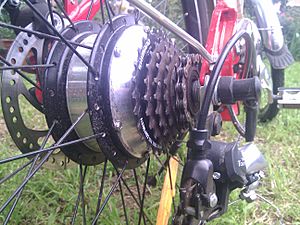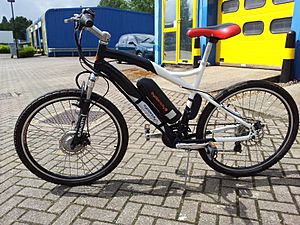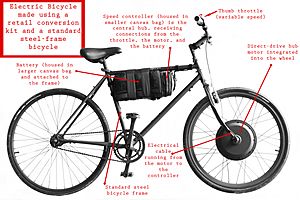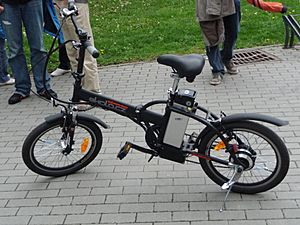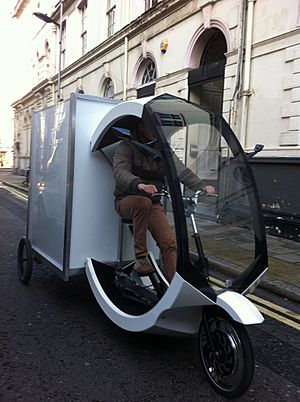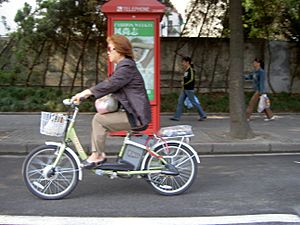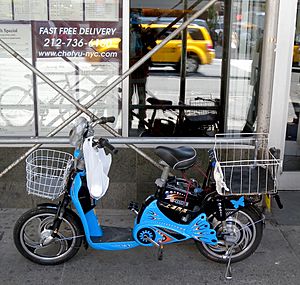Electric bicycle facts for kids
An electric bicycle is like a regular bicycle, but it has an electric motor to help you pedal. These bikes are great because they don't pollute the air. You can usually choose how much the motor helps you. For example, it might give you 50% of the power you need to move forward. Electric bikes have become very popular. You can even turn a normal bike into an electric one using a special kit!
Contents
Why Are E-Bikes Popular?
Electric bikes have grown super fast since 1998. In 2016, there were 210 million electric bikes used every day around the world! In China, there were about 120 million e-bikes in 2010, and sales are still growing quickly in places like India, the United States, Germany, the Netherlands, and Switzerland. Europe sold 700,000 e-bikes in 2010, which was a big jump from 200,000 in 2007.
Today, China makes the most e-bikes in the world. In 2004, Chinese companies sold 7.5 million e-bikes in their country. This number grew to 10 million in 2005 and 16 to 18 million in 2006.
How E-Bikes Work

Motors and How They Drive the Bike
The most common motors in electric bikes are called "hub motors." These can be brushed or brushless. There are many ways to add electric power to a bike. Some motors are built into the wheel hub, and others use gears. You can add an electric system to almost any bike using a chain, belt, or even by rubbing against the wheel.
A common modern design is the BLDC hub motor. Here, the motor is actually built right into the wheel hub. This means the bicycle wheel itself is the motor! The power of these motors is often limited by law, usually to under 750 watts.
Another popular type is the mid-drive system. With this, the motor isn't in the wheel. It's usually placed near the pedals, under the bottom bracket. This motor then uses a chain or belt to help turn the pedals. So, the power goes through the bike's normal gears to the wheel.
Batteries That Power E-Bikes
Electric bikes use rechargeable batteries to store energy. Common types include sealed lead-acid (SLA), nickel-cadmium (NiCad), nickel-metal hydride (NiMH), or lithium-ion polymer (Li-ion). Batteries are different in their voltage, how much charge they hold, their weight, and how many times they can be charged before they wear out.
It doesn't cost much to charge an e-bike, but replacing the battery can be expensive. How long a battery lasts depends on how you use it. Charging it often, but not letting it run completely empty, can help it last longer.
How far an e-bike can go on one charge (its "range") is important. This depends on the motor, battery size, how well the electronics work, how windy it is, and the weight of the bike and rider. Some e-bikes can even use regenerative braking. This means the motor helps slow the bike down and also puts a little bit of energy back into the battery. This can help you go further and make your brake pads last longer. Some new ideas even use fuel cells or super capacitors instead of batteries.
Controllers: The Brains of the E-Bike
Controllers are like the brains of the e-bike. They manage how much power the motor gets. There are different controllers for brushed and brushless motors. Brushless motors are becoming more common because their controllers are getting cheaper.
For brushless motors, controllers use special sensors to know how fast the wheel is turning and how much you're pedaling. The controller then gives power to the motor based on this information, your speed, and how much help you need. These controllers often have a throttle (like a twist grip) and can keep your speed steady. They also protect the motor from too much power or heat. If your bike has "pedal assist," a sensor near the pedals tells the controller how fast you're pedaling. The controller then uses pulse-width modulation to control the motor's power.
Controllers for brushed motors are simpler and cheaper because they don't need as many sensors.
Different E-Bike Designs
Not all e-bikes look like regular bikes with a motor added. Some, like the Cytronex bikes, hide the battery to look like a water bottle. Others look more like small motorcycles, but they use an electric motor instead of gas. For example, the Sakura e-bike has a motor like other e-bikes but also has plastic covers, lights, and a speedometer, making it look like a modern moped.
You can convert a normal bike into an e-bike. There are kits that let you replace a wheel with one that has a motor inside. Some kits replace the rear wheel, like FlyKly. Others replace the front wheel, like the EVELO Omni Wheel.
Another design is an Electric Pusher Trailer. This is a trailer with a motor and battery that pushes any bicycle. The two-wheeled Ridekick is an example.
Some e-bikes are designed just for fun, like "chopper" style e-bikes. Electric cargo bikes are also popular. They help you carry big, heavy things that would be hard to move on a regular bike.
Many e-bike designs follow local laws, especially those with pedals, so they can be used on roads in many countries. Folding e-bikes are also available, making them easy to store or carry on public transport.
Electric self-balancing unicycles are also electric cycles, but they usually can't be used on roads. They are often used for short trips in cities or combined with public transport.
Electric Tricycles
Electric trikes (three-wheeled bikes) are also made to follow e-bike laws. They are more stable at slow speeds, which makes them good for people with disabilities. Electric cargo bikes with three wheels are also becoming popular for delivering packages in cities. Some of these look like a mix between a bike and a small van!
Health Benefits of E-Bikes
E-bikes can be really good for your health! They can help people who are recovering from heart problems. Doctors often suggest using a stationary bike first, and then e-bikes can be a safe step up. They require less effort on your heart than a regular bike.
E-bikes are also great for people who find it hard to exercise for a long time, maybe because of an injury or weight. The motor can help them take breaks from pedaling. This gives riders confidence that they can finish their ride without getting too tired.
Some people have even lost a lot of weight by using an electric bike. Since the motor helps with hills or long distances, people who might not normally ride a bike can use the electric help when they need it and pedal when they can.
How E-Bikes Affect the Environment
Electric bikes are "zero-emissions vehicles." This means they don't produce any pollution from burning fuel while you ride them. However, we do need to think about the pollution from making electricity to charge them and from making and getting rid of their batteries. Even with these things in mind, e-bikes are much better for the environment than cars, especially in cities.
You can make the environmental impact even smaller by charging e-bikes with solar power or other clean energy sources. Some places even have "solar parking lots" where you can charge your e-bike using solar panels while it's parked.
Because e-bikes are good for the environment, some cities use them for their police or other services. China's e-bike makers are even working with universities to make their technology more environmentally friendly.
Some people worry that e-bikes might damage mountain bike trails or cause safety issues. However, one study found that low-powered electric mountain bikes might have a similar impact on trails as regular mountain bikes.
A recent study compared the environmental impact of e-bikes to other ways of getting around:
- E-bikes are 18 times more energy efficient than a large SUV.
- They are 13 times more energy efficient than a regular car.
- They are 6 times more energy efficient than rail transit.
- And they have about the same environmental impact as a regular bicycle!
One concern is how to get rid of old lead batteries, which can pollute the environment if not recycled properly. Also, lithium-ion batteries have strict shipping rules because of safety.
E-Bike Safety on Roads
In China, where many e-bikes are used, there have been concerns about road traffic safety. Some cities have thought about banning them from bicycle lanes. As more e-bikes are used, and some have powerful motors that can go up to 30 miles per hour, the number of accidents has gone up in China.
E-bike riders are more likely to get hurt in a crash than car drivers. Since e-bikers use regular bike lanes, they mix with slower bikes and people walking, which can increase the risk of crashes.
E-Bike Use Around the World
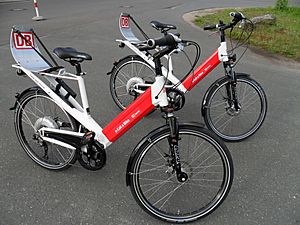

China
China has seen a huge increase in e-bike sales. Sales jumped from 56,000 in 1998 to over 21 million in 2008! By 2010, there were an estimated 120 million e-bikes in China. This happened because many Chinese cities started limiting motorcycles to reduce traffic and accidents. People began using e-bikes instead of traditional bikes and motorcycles, and they became a popular way to get to work.
However, safety is still a concern. About 2,500 deaths related to e-bikes were reported in 2007. By late 2009, ten cities had banned or limited e-bikes for the same reasons as motorcycles.
China is the world's top e-bike maker, producing 22.2 million units in 2009.
India
The first pedal-assisted bikes arrived in India in 1993. By 2008, e-bike sales were higher than moped sales. Recently, e-bikes that can carry two or even three people (two adults and a child) have become available in India.
Netherlands
The Netherlands is famous for its bikes, with 18 million bicycles in total. By 2009, e-bikes made up 10% of the market. Sales quadrupled from 40,000 in 2006 to 153,000 in 2009. Even though e-bikes are about three times more expensive than regular bikes, by early 2010, one out of every eight bikes sold in the country was electric.
A 2008 study showed that people in the Netherlands traveled further on e-bikes for their commutes (about 9.8 km) compared to regular bikes (6.3 km). E-bikes are especially popular with people aged 65 and older, and they are often used for fun rides, shopping, and errands.
United States
In 2009, there were about 200,000 e-bikes in the U.S. By 2012, they became very popular in New York for food delivery.
In 2012, two e-bike fans rode electric bikes across the U.S. from New York to San Francisco (4,000 miles!) to show how great e-bikes are in cities. Pedego Electric Bikes is a very popular brand in the U.S.
Many e-bikes in the U.S. are regular bikes that have been converted using a kit. These kits usually include a motor (often in the wheel), a speed controller, a throttle, wires, and a battery. Some U.S. companies sell these kits with advanced lithium batteries. Big bike companies also sell complete e-bikes. For example, Trek offers e-bikes where you can program how much the motor helps you, from 25% to 200% of your own power. This helps make sure you're still pedaling and also follows laws in some European countries.
One challenge for electric bikes in the U.S. has been lower gas prices, which makes people less likely to switch from cars.
Images for kids
-
E-bikes and electric scooters in a specialized shop in Beijing in 2008. (Y2750 is around US$400)
-
E-bikes are common in China, with an estimated fleet of 120 million in early 2010.
See also
 In Spanish: Bicicleta eléctrica para niños
In Spanish: Bicicleta eléctrica para niños


